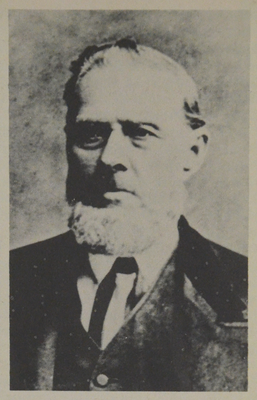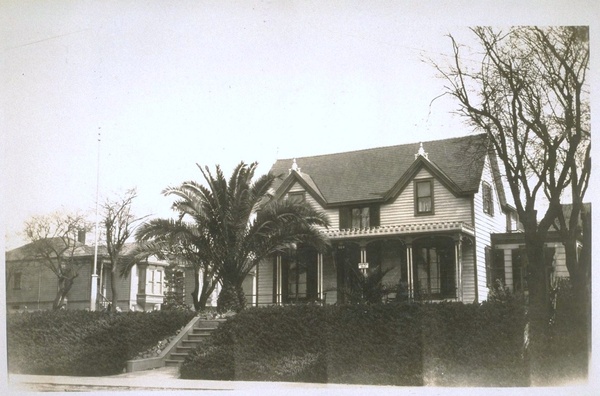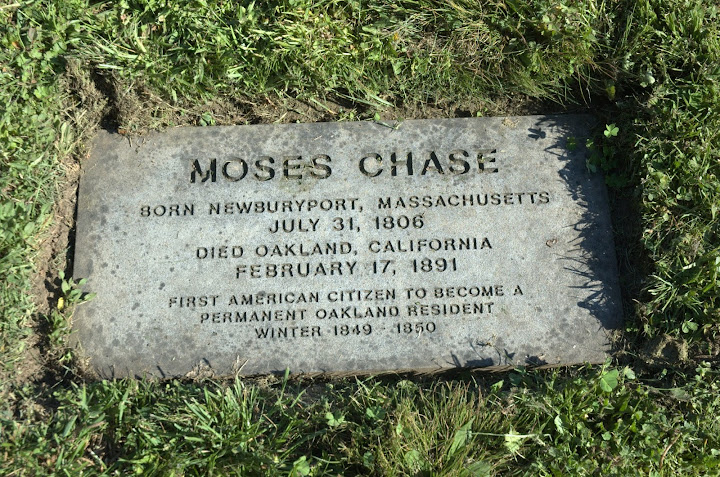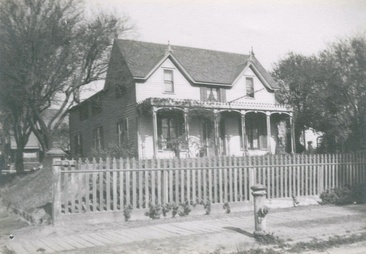 from The Beginnings of Oakland by Peter T. Conmy
from The Beginnings of Oakland by Peter T. Conmy
Moses Chase (July 31, 1806 – February 17, 1891) was the first American citizen to settle in what is now Oakland, and was the founder of the town of Clinton. In 1850 Chase leased a tract of land from one of the four sons of Don Luis Maria Peralta, the Spaniard with the original land grant.
Before arriving in California, Chase was the captain of the sailing ship Capitol which sailed from England to the Indies around Cape Horn.
Chase married Emily Stickney on February 17, 1840 and his first child, George Chase, was born April 17, 1841. Sadly, Emily died on May 11th, 1841.
Hearing of the California Gold Rush, Chase sailed from Boston on January 15, 1849 aboard the Capitol on a 176-day voyage. He hoped to make his fortune panning for gold, then return home to marry Mary Ellen Clinton, his second wife-to-be.
After an unsuccessful attempt at gold mining and illness with what was called ‘mountain fever,’ he returned to the San Francisco area, where he put up a tent at the West Oakland Point, and supported himself by hunting. He later moved his tent to what is now the foot of Broadway, and later to the 4th Avenue and E. 9th Street site of the first wooden frame house which measured 14′ by 24′.
Chase met and formed a partnership with the three Patten brothers, who also leased 640 acres of land from Vicente Peralta in the town of Clinton (now part of Oakland).
According to George Chase’s biography, Moses Chase “… and three Patten brothers leased from Peralta a body of land extending over and beyond what became Clinton. After a few years the land was sold by Peralta subject to their lease, and they obtained “Clinton” in settlement of their claim, which they subdivided into building lots and which was known as Clinton. They also built the first hotel in what is now known as East Oakland, and the largest on this side of the bay. It was called the Clinton House. This was burned during Mr. Chase’s absence in the East in 1853, and proved a total loss, there being no insurance in those days. He returned in 1853 by the Isthmus route, and his son George followed in 1854, in company with his aunt Mary and her husband, James Allen. The mother, Emily (Stickney) Chase, died in Newburyport, May 11, 1841, when George was but three weeks old.”
Moses built his house, the first wooden framed homestead in Oakland, at the corner of East 8th Avenue and 1st Street; his last direct descendant and grandson Albert Boynton Chase still lived in the home 75 years later. 1 Other sources list his home as located at the corner of 4th Avenue and East 10th Street, and being built in 1862. 2 The address of his house was 404 East 8th Street. 2 The house is now gone and the property is now part of Laney College.
When Moses Chase returned home to marry Mary Ellen Clinton, he discovered she had died while he was in California. He returned to Oakland and named landmarks in her honor: the village of Clinton on the eastern shores of Lake Merritt, Clinton Street, Clinton Park and the square block around Clinton Park. 2
 Moses Chase house, northeast corner of East 8th Street and 4th Avenue, East Oakland 3 (October 5, 1928)
Moses Chase house, northeast corner of East 8th Street and 4th Avenue, East Oakland 3 (October 5, 1928)
The above photo of Moses Chase’s home had the following lengthy caption: situated on the northeast corner of ”East Eighth Street and Fourth Avenue, East Oakland, front view. This home was built by Moses Chase in 1849 on part of the 640 acres he bought from [Vincente Peralta], who at the time owned a large part of what is now Alameda County. This lot was later a part of the Township of Clinton. Moses Chase was born in Newburyport, Mass. on July 31, 1806. He was the first white man in Oakland, and he camped at the foot of what is now Broadway in 1849. The rear rooms of this house were built in 1849 of ship’s timbers, driftwood and redwood shakes. Later, in 1856, the front part of the house was added.” 3
Death
Moses Chase died in 1891, and is buried in Mountain View Cemetery.
 Moses Chase marker
Moses Chase marker
photo CC SA-BY Our Oakland  Another view of Moses Chase’s home (the first house built in Oakland)
Another view of Moses Chase’s home (the first house built in Oakland)
The following account of Moses Chase appeared in the Note from the Chase Chronicles - Jan. 1932:
OLD CALIFORNIA CITY
“The site of Oakland, California, was part of the holdings of Don Luis Maria Peralta, who received vast grants from the Spanish crown. In 1842 he divided his lands among his four sons and the two to whom this region fell established themselves on their estates. From one of them in 1850 Moses Chase leased a tract, and he became the founder of the future city. In 1852 the settlement was incorporated as a town and in 1854 it was chartered as a city. The name was suggested by the grove of oaks in which the first houses were built.” (Boston Sunday Post, Jan. 31, 1932)
Chase Chronicle - Oct. 1926:
OLDEST HOUSE RIDICULES TIME
Home of Moses Chase still as sturdy as ever
”Surrounded by a well-kept lawn at the intersection of East 8th-avenue and 1st street, stands proudly and sturdily the first homestead built in Oakland, California.
The old house in its 75th year, was built at the beginning of the gold rush by Moses Chase, the first white man to settle in Oakland.
The residence is now the home of Albert Boynton Chase, a grandson and the last direct descendant of Moses Chase, whose son was the late George Chase, county treasurer of Alameda county for years.
GRANDSON REMINISCENT
Albert Chase is proudly reminiscent of the days when, as a boy, he heard with glowing interest of how his grandfather rounded Cape Horn, the skipper of the sailing ship Capital plying between England and the Indies.
He heard of his grandfather’s desire to quit the life of a sea captain and return to his native home, Newburyport, Mass. Of how, after leaving the call of the sea for the lure of the land, Moses Chase learned of the gold to be found in California. The west then became his objective and upon arriving he joined a band of prospectors and mined in the primitive fashion of the day.
The first California home of the elder Chase was a tent pitched at what is now the foot of 7th-street, where it joins the mole. His only neighbors were the Peraltas, who owned all the land west of San Leandro.
OLD HOME WELL BUILT
The word “home” began to pound itself into the heart and mind of the sea captain and he began building a real house and home, carrying lumber from an old sawmill to the spot on which stands the old Chase home.
Visitors note the fine carpentry work done in the house and especially in the spacious old kitchen, the side walls and ceilings still being held firmly together by the wooden pegs driven in by the erstwhile and ambitious Moses Chase.
An old six-barrel firing piece, a boot-jack and a 100-year-old rug are among the interesting antiques shown by the pioneer’s grandson.” (San Francisco Daily News)
Oakland Tribune - Feb 18, 18914:
THE FIRST SETTLER.
The Oldest Inhabitant Has Gone to Rest.
MOSES CHASE'S TENT ON THE BEACH.
Oakland in the Days When Oaks Were Here and the Peraltas Owned all the Land.
Moses Chase, who holds the proud distinction of having been the first American to settle on the eastern side of the bay, in the territory now known as Oakland, died at his residence 202 East Ninth street, yesterday afternoon, after a brief illness. The real cause of death was old age. The deceased was 84 years and six months of age and leaves a son, George C. Chase, who is a deputy in the office of County Treasurer Socrates Hoff.
Arrangements have been made to hold the funeral on Thursday next.
In the autumn of 1889 Moses Chase himself gave the following account of early days in California to a TRIBUNE reporter:
He was born in New Bedford, Mass., in 1806, and from the time he was old enough followed a mariner's life, casting his lot with the old whalers, for which New Bedford is so noted, and making several voyages in merchantmen to the four quarters of the globe. In 1849, when the gold excitement broke out in California, then under Mexican rule, Mr. Chase was one of the first to get the fever, and he shipped on the vessel Capital with Captain Thorndyke Proctor for the voyage around the Horn. On the morning of July 19th the good ship sailed into the San Francisco bay and anchored near where the corner of Sansome and Clay streets now is.
Directly on landing at the beach near the foot of Clay street he hunted up a prospecting party, and together they set forth two days later for the interior. The party mined along the Feather river and its tributaries and six months later Mr. Chase made his way back to San Francisco and resolved to give up mining. During the winter of '49-50 he rigged up an old whale boat for a cruise around the bay, and finally landed on the beach where the foot of Broadway now is. The country was covered with pine and oak trees, and the sandy soil was thickly covered with a heavy growth of grass nearly two feet high. It was a picturesque spot and wild game was plentiful, so Mr. Chase pitched him a tent and went into the business of pot hunting for the San Francisco settlement, his only neighbors being the Peraltas, owners of all the land west of San Leandro creek to the bay, who then resided in an adobe up near where San Leandro now is. Other than these, no settlers had lived in this broad expanse of country, and to Mr. Chase can clearly be given the credit of being the first white settler on this side of the bay. It was here the Pattens found him. The Patten brothers, R. F., William, and E. C., are children of William and Ruth Patten, who lived in Washington county, ME. R. F. Patten, who told THE TRIBUNE his story, was born on February 8, 1798. His brother, William, was born in December, 1799, and the other brother, who died in 1852, was born in 1800. The Patten boys followed the trade of their father, that of tanning, until they, too, were stricken with the gold fever and resolved to come to California. E. C. Patten was the first to leave, and a month later he was followed by the other brothers, who sailed from Boston in the ship Sweden, Captain Cotting, master, on March 1, 1849, arriving at the Golden Gate on the 1st day of August of the same year, where they met with their other brother. But the brothers never got into the mines. They remained in San Francisco until February 27, 1850, when they hired a whaleboat and sailed across the bay to the wilderness here. Being impressed by the luxuriant vegetation and the climate, which was as different from San Francisco as it is now, they resolved to locate here and go to farming. They landed and went ashore at nearly the exact spot where the Southern Pacific Railroad bridge now touches the East Oakland shore, and pitched their tent in the vicinity of Badger's Park. They had been told that that the Spaniards who owned all the land on this side would not dispose of any of the ground, but nothing daunted, they resolved to see for themselves.
The Peralta brothers, Ygnacio and Antonio, who were living near the San Leandro creek in an adobe house, were called upon, and after much bickering Antonio Peralta gave them a lease to 160 acres of land for eight years. The ground comprised all that territory between the north end of the estuary and about where Twelfth avenue is now. The country was wild, not a white man around, and vast herds of wild cattle and mountain lions roamed at will. In the daytime nothing was seen of them, and they kept back in the mountains until night, when they came down to the bay shore, and many a fight did the settlers have to defend their belongings. In the month of February, 1850, while hunting on the side of the creek, the brothers came across the tent of Mr. Chase. They found him very sick and quite discouraged, and after doctoring him with their wild remedies they proposed that he come over and join them, instead of returning to his home, as was his intention. The result was Mr. Chase entered into partnership with the Patten brothers, and a year later a large clearing had been made and about 100 acres set out in barley and wheat. Mr. Chase built him a house from lumber obtained from an old Spanish sawmill near Fruit Vale, where now is the corner of Ninth street and Fourth avenue, and this old house now forms a part of the one in which he now lives, at 251 East Ninth street.
In 1851-52 the Pattens built their house, and a portion of the old structure is now a part of their residence at the southeast corner of Seventh avenue and East Eleventh street.
In the meantime the old Spanish claim to the ground on which they were located was unsettled, and action was commenced in the Mexican courts to quiet title. So, in order to be safe they took up three preemption claims and later they got a lease of 800 acres of the ground for a term of eight years. While the claims were in court the Peraltas employed C. B. Strode, of the law firm of Jones, Tompkins & Strode, in San Francisco, to defend the Peralta claims to the land. The result was that the Peralta brothers got their patent, and in 1854 they deeded 6000 acres of land to Strode for his services, including that held by the Pattens and Moses Chase, and he notified them that they were his tenants. While all this was going on in '51-2, H. W. Carpentier and others sailed over the bay and took up squatters' claims at the foot of Broadway. A few months later Mr. Strode made the Pattens and Mr. Chase an offer of a gift of one-half their leased possessions under the condition that they would have it surveyed and placed on the market in town lots. This they did, and the town of Clinton sprung into existence. The first lots sold was all that property now owned by Captain T. W. Badger, known as Badger's Park, which was bought by Captain J. Nagle. E. C. Patten died in April, 1852, from the result of an injury.
In 1854 William Patten was married to a Miss Nagle, daughter of the man who first invested in their town lots. Mrs. Patten died about seventeen years ago. Robert F. Patten never married.
Links and References
- Old California City
- OMCA Collections
- UC Berkeley, Bancroft Library - Image(s) used by permission
- THE FIRST SETTLER - Oakland Tribune, 18 Feb 1891, Wed, Page 6



